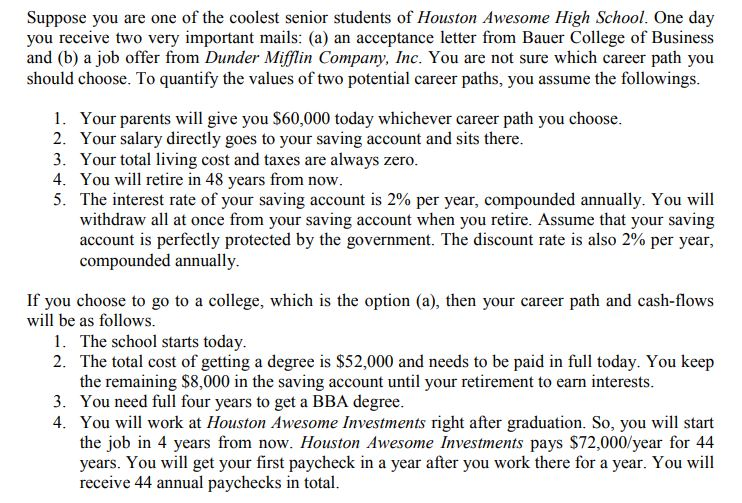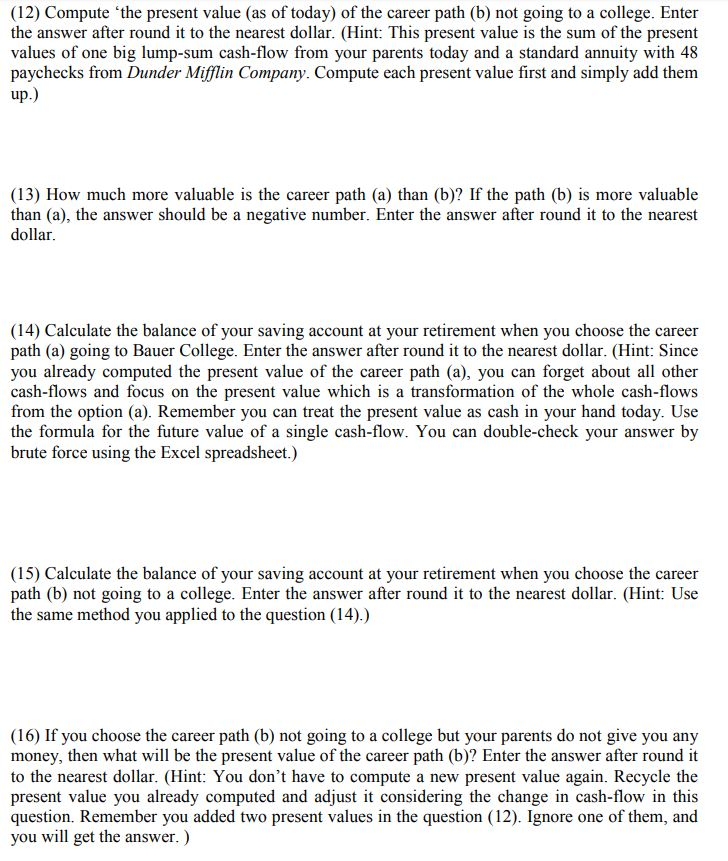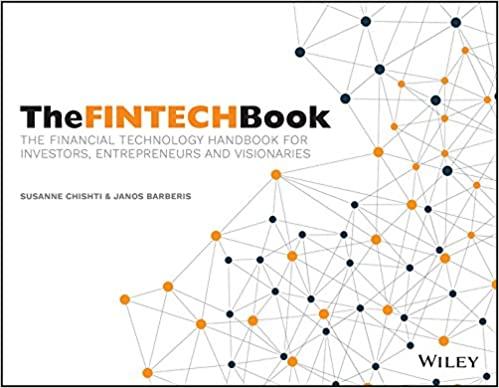


Suppose you are one of the coolest senior students of Houston Awesome High School. One day you receive two very important mails: (a) an acceptance letter from Bauer College of Business and (b) a job offer from Dunder Mifflin Company, Inc. You are not sure which career path you should choose. To quantify the values of two potential career paths, you assume the followings. 1. Your parents will give you $60,000 today whichever career path you choose. 2. Your salary directly goes to your saving account and sits there 3. Your total living cost and taxes are always zero. 4. You will retire in 48 years from now. 5. The interest rate of your saving account is 2% per year, compounded annually. You will withdraw all at once from your saving account when you retire. Assume that your saving account is perfectly protected by the government. The discount rate is also 2% per year, compounded annually. If you choose to go to a college, which is the option (a), then your career path and cash-flows will be as follows. 1. The school starts today. 2. The total cost of getting a degree is $52,000 and needs to be paid in full today. You keep the remaining $8,000 in the saving account until your retirement to earn interests. 3. You need full four years to get a BBA degree. 4. You will work at Houston Awesome Investments right after graduation. So, you will start the job in 4 years from now. Houston Awesome Investments pays $72,000/year for 44 years. You will get your first paycheck in a year after you work there for a year. You will receive 44 annual paychecks in total. If you choose not to go to a college, that is, the option (b), then your career path and cash-flows will be as follows. 1. You deposit $60,000 from your parents into your saving account and never withdraw until you retire 2. The job at Dunder Mifflin Company, Inc starts today and the company pays $63,000/year for 48 years. You will get your first paycheck in a year after you work there for a year. You will receive 48 annual paychecks in total. There are additional assumptions you should make since this is a real world problem. 1. The firms will exist forever and your employment is guaranteed until your retirement. 2. Your decision on the college education is irreversible and you are stuck with the chosen career path until your retire. Note this is a decision on your career path and also an investment decision. Consider yourself as an asset ("Human Capital') that generates cash flows in the future. The value of yourself as an asset depends on which career path you choose. Therefore, this is an investment decision. Now, answer the following questions. Drawing a time line with cash-flows will help you understand the complicated future cash-flows. If you are confused or not sure about your final answers, use the Excel spreadsheet"PS1 To College or Not.xlsx" to make sure your calculation is correct by brute force (using the lengthy general present value formula implicitly). Note you need to change inputs in the gray box properly. However, I hope you can find your final answer using formulas (PV, FV, and Annuity) you learned from the class. (10) Compute the (present) value when you start the job of 44 annual paychecks from Houston Awesome Investments when you choose the career path (a) going to Bauer College. Enter the answer after round it to the nearest dollar. (Hint: The present value can be defined at any date, not just today. Imagine you take a time machine and go to the future, 4 years from now, and compute the present value there. Here, you can use the formula for an annuity because the timing of the first cash flow is consistent with the formula.) (11) Compute the present value as of today" of the career path (a) going to Bauer College. Enter the answer after round it to the nearest dollar. Hint: Remember 'present value of present value'. Now you can forget about the actual cash-flows from the paychecks. Instead, you can assume there is only one hypothetical cash-flow in 4 years from now whose amount is the same as your answer for the question (10). Therefore, the present value of the career path (a) is equal to the present value (as of today) of such hypothetical cash-flow (in 4 years from now) that you computed for the question (10), plus the net cash-flow today. (12) Compute the present value (as of today) of the career path (b) not going to a college. Enter the answer after round it to the nearest dollar. (Hint: This present value is the sum of the present values of one big lump-sum cash-flow from your parents today and a standard annuity with 48 paychecks from Dunder Mifflin Company. Compute each present value first and simply add them up.) (13) How much more valuable is the career path (a) than (b)? If the path (b) is more valuable than (a), the answer should be a negative number. Enter the answer after round it to the nearest dollar. (14) Calculate the balance of your saving account at your retirement when you choose the career path (a) going to Bauer College. Enter the answer after round it to the nearest dollar. (Hint: Since you already computed the present value of the career path (a), you can forget about all other cash-flows and focus on the present value which is a transformation of the whole cash-flows from the option (a). Remember you can treat the present value as cash in your hand today. Use the formula for the future value of a single cash-flow. You can double-check your answer by brute force using the Excel spreadsheet.) (15) Calculate the balance of your saving account at your retirement when you choose the career path (b) not going to a college. Enter the answer after round it to the nearest dollar. (Hint: Use the same method you applied to the question (14).) (16) If you choose the career path (b) not going to a college but your parents do not give you any money, then what will be the present value of the career path (b)? Enter the answer after round it to the nearest dollar. (Hint: You don't have to compute a new present value again. Recycle the present value you already computed and adjust it considering the change in cash-flow in this question. Remember you added two present values in the question (12). Ignore one of them, and you will get the answer.)









